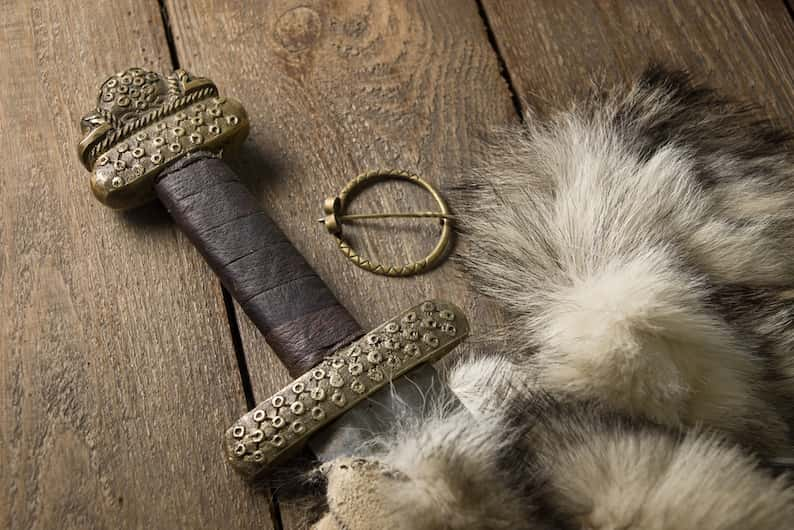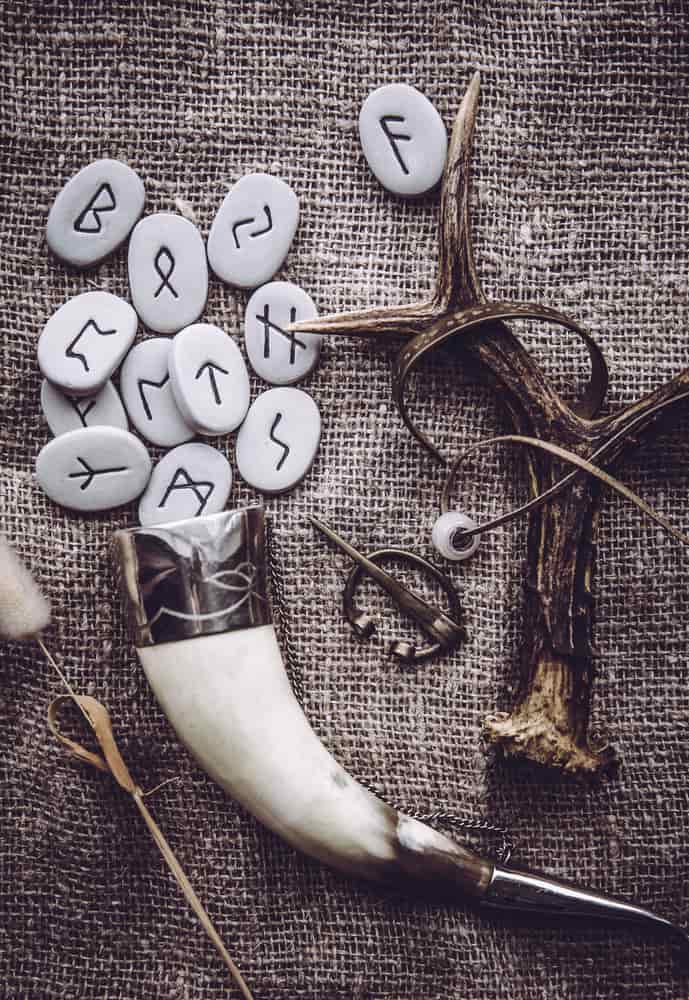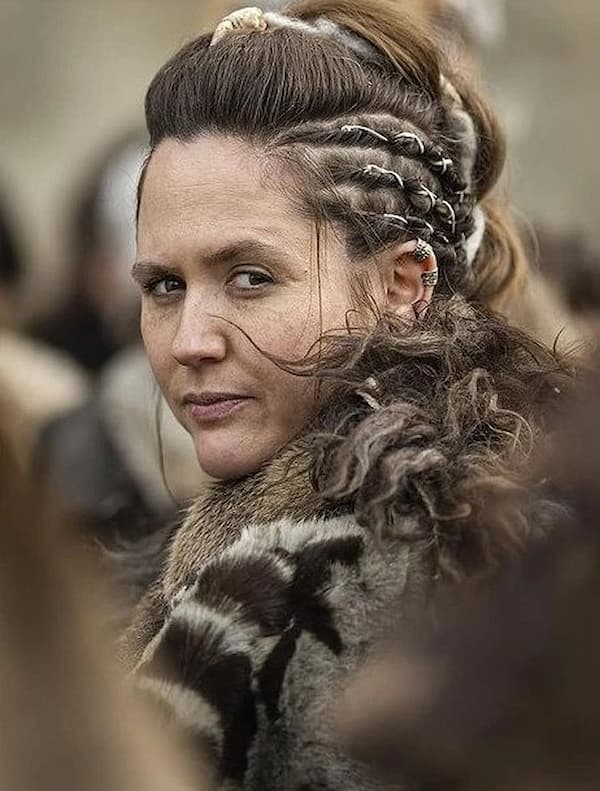The history of jewelry is a long, complex tale that goes back to the dawn of time. The love of jewels, gems, and body ornaments has been enjoyed by kings and queens, religious icons, fashionistas, and peasants alike, and so the question of whether Vikings had piercings fits perfectly with that line of thought.
In particular, looking into things like Viking ear piercings and Viking ear cuffs leads to a rabbit hole of history about jewels and the human love affair with self-adornment.
I loved sitting at my grandmother’s vanity as a child, donning her costume jewelry, pretending to be royalty. And I was not the first youngster to do so.
In ancient times, jewelry was created with bones, feathers, and shells. As humankind learned to extract metals and gems from the earth, they evolved into amulets, brooches, earrings, and bracelets.
Whether it was a trophy from a hunt, a symbol to ward off evil, a sign of commitment, or pure opulence, history is littered with images and relics showing our love for jewelry. But did this include any Viking piercings or other jewelry? Let’s find out.

Table of Contents
Ancient earring history
In 1991, hikers in the Austro-Italian Alps discovered the oldest human mummy. He had been preserved in ice over 5,000 years ago and had pierced ears.
Slightly more recently, ear piercings were a sign of nobility in the Elizabethan era, and sailors used them as a life insurance policy. For example, if they died at sea, the earring could be sold to pay for their funeral.
Superstition implies that demons and spirits could enter the body through the ear. Metal was believed to ward off evil, and the earring was placed in the earlobe for protection.
The western world was a bit slow to the party regarding nose piercings. More conservative types still see it as a sign of rebellion, favored by punks in the 1980s and worn by non-conformists and hippies.
However, interestingly, the first written mention of a nose piercing was in the Bible, in Genesis, when Abraham offers a golden nose ring to his future daughter-in-law, Rebekah.
Piercings as the mark of a warrior
Warriors donned septum piercings for millennia, and they still form a part of tribal cultures. For example, many Polynesians and South American tribes would thread large boar tusks, and other objects slipped through the septum. This was to make them look intimidating and fierce to their enemies.
Similarly, lip labrets, a piercing on the lower lip, was a mark of beauty in pre-Columbian cultures, and the bigger, the better! They were often stretched and fitted with large wooden discs, stretched to incredible sizes.
The Aztecs and Mayans also practiced tongue piercing as a part of blood sacrifice. They also believed it made it easier to communicate with the gods. In addition, they wore labrets made of jade and gold, which was thought to enhance their sexuality.
Did Vikings have piercings?
Surprisingly, Vikings did not have ear piercings, not any other type of piercing, for that matter. They were conscious of their appearance, wore plenty of jewelry such as necklaces and rings, and encouraged self-expression, but piercings was not something that ever seemed to take off.
The history of the Vikings has a few blurry spots. Unfortunately, they didn’t keep a written history, so everything we know about them has been recorded after the fact. Instead, Viking history is based on their oral tradition and archaeological findings. This means that what is depicted in literature today has often proved to be inaccurate.

And when it comes to what Vikings looked like, piercings are not the only thing absent from Viking traditions. For example, the often-implied horned helmets and double axes have no historical basis, and no evidence of these has ever been found (although there may be some more historical truth to those elaborate Viking braids).
From Hagar the Horrible, to the hit show Vikings, plenty of poetic license has been taken when it comes to adornments and body piercings.
Why did Vikings not have piercings?
Some historians think it may have been a practical decision for Vikings to not wear piercings. They could get in the way of a violent clash, catching on clothing and weaponry. Getting a nose ring ripped out in battle could seriously slow one down and make one vulnerable to infection.
Body piercings are conspicuous by their absence in Viking history. It wasn’t that they were opposed to body modification. On the contrary, the Vikings embraced tattooing (Viking face paint isn’t just for TV shows) and often covered their entire face or body with markings. They just didn’t seem to care for piercings.
However, despite this, it’s interesting that simply Googling “Viking jewelry” shows you a bombardment of images of Viking and Norse earrings. While these definitely look cool, it is tempting for purists who know better to write in the comments section: “But…there were no Viking earrings!”
What earrings did Vikings wear?
Vikings were exposed to numerous other cultures and traditions as pioneers and explorers. For example, earrings of Slavic origin have been found in Viking ruins, although these draped over the ear rather than being worn as a piercing.
The Slavs, in turn, had come across ear cuffs on their travels to Asia and the Middle East. These were often seen on Indian brides who wore elaborate designs, and the upper class dressed their ears in precious metals and jewels.

Less complicated, slightly more gothic versions of these were brought home by the Slavs from their adventures and, from there, the Viking ear cuff was born. However, these don’t quality as Viking piercings as, unlike earrings, ear cuffs extend from the lobe to the top of the ear, along the outside.
This doesn’t make them any lesser though, as many of them were intricately designed and made of bronze or silver. It is believed that they may have served as light armor, protecting the ears from minor blows during a scuffle or battle.
What kind of jewelry did the Vikings wear?
The Vikings loved their jewelry. Both men and women adorned themselves with ornaments and trinkets of all shapes and sizes. Married couples exchanged beautifully crafted silver rings during their wedding ceremony, and warriors proudly adorned themselves when they went into battle.
Precious stones and charms would embellish the designs. Oval brooches engraved with intricate patterns would pin clothing together, and wealthy Viking men would use glass and amber beads to decorate their beards.

Source: The Portable Antiquities Scheme/The Trustees of the British Museum (CC BY-SA 2.0)
Adjustable, unevenly sized rings were found at burial sites. Intricately designed armbands were also the height of fashion, braided from wire and silver.
Viking jewelry had a dual purpose for both male and female Vikings. First, it was very much ornamental, as they had a deep love for beautiful things, often symbolic of their conquests. It’s for a similar reason why it’s thought that Vikings wore makeup.
They also used jewelry as currency. Silver adornments would be hacked up and used for payment. It was known as ‘Hack Silver’.
Did Vikings wear more gold or silver?
Silver and bronze were the metal of choice for Vikings. Because silver served as currency, much of the men’s jewelry was made from this to make their pieces portable, similar to acting as a wallet. Women’s jewelry tended to favor bronze and featured a lot of precious stones.
Gold was not unheard of but was reserved for very high-ranking, wealthy families. The Vikings also valued iron and mined it for many things, including jewelry and weapons.
Trinkets were often engraved or molded to show religious significance. Mjolnir, the hammer of Thor, was the most popular.
Yggdrasill, a giant ash tree supporting the universe, was also significant, as were Odin’s Ravens, Huginn and Muninn, and Odin’s Horns, known as the Triskelion.

Final thoughts
The Viking Age was from about 700 to 1100 AD. Their home was the Scandinavian region that is now made up of Norway, Denmark, Finland (although not all of it – check out our article on Vikings in Finland to get the full picture), Sweden, Iceland, Greenland, the Faroe Islands, and Åland. History often depicts the Vikings as bloodthirsty barbarians, but recent interest in their mythology has led many of us to dig deeper.
In particular, they’ve quickly become many people’s favorite ancient culture, having been glorified by pop culture of late. This includes not only the TV show Vikings, but also Chris Hemsworth’s portrayal of the Norse god Thor, which had many admirers ready to pack their bags and wait for the Valkyries to take them “until Valhalla“.
While they were fierce warriors, the Vikings were surprisingly sophisticated for their time. They were skilled craftsmen, with their experience extending to anything from jewelry (if not Viking ear piercings) to revolutionizing seafaring with their longboat designs. Vikings were also traders, farmers, and explorers. For instance, they discovered North America long before Columbus ever set sail.
With all this in mind, appearance meant a lot to them. And while Viking piercings may not have been a thing (nor, perhaps, were Viking dreadlocks for that matter), Viking ear cuffs have definitely been discovered, showing how fashion and style really haven’t changed as much over the years as we may first think.
